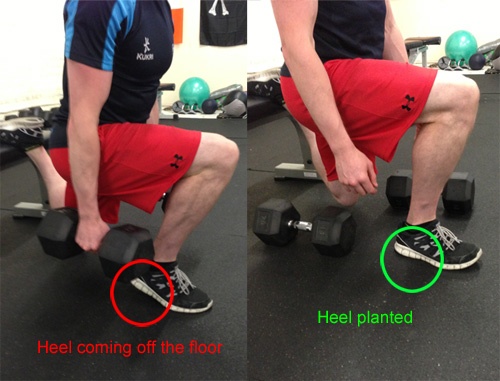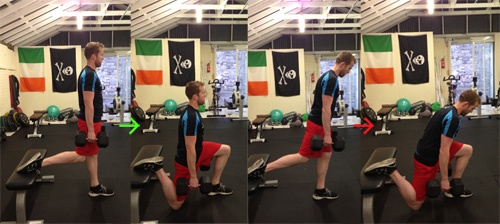Bulgarian Split Squat Technique
Recently I filmed the below video on Bulgarian Split Squat technique and its benefits. In true last minute style I went through it a little too fast (it was the end of a long day!) but I thought it would be a good idea to write a small article to accompany this video. I also realised afterwards that I committed the sin of recording with the phone at the wrong angle…
Since attending the OPT assessment seminar in Sweden last year I have started to incorporate Split Squats into my own training more and from there programming them into the classes here at the gym.
From a personal point of view, I have an old back injury and as much as I love Back Squatting, it can aggravate my back, no matter how good my technique feels. The (Bulgarian) Split Squat is a great way of keeping my legs strong, building muscle while keeping my back unloaded and pain free. This is the reality for some folks whether they like to admit it or not, it could be due to an old injury or even just body shape (those dreaded long femurs) but some movements can be a no-go and this is a great substitute for me when it comes to a workaround for Back Squats or for instance even when I am quite tight (after my latest trans Atlantic journey!) .
With the above in mind, it is also worth noting that the lower back can often be the limiting factor in the Back Squat and with the Split Squat you are taking this limiting factor out of the equation. And as you aren’t loading the spine as you would during a Back Squat, the recovery is typically faster and it is less of a CNS hit.
Although it is considered a unilateral movement, the back leg does work to stabilize and allow the front leg to work harder. And not only will the front leg be working but the rear hip flexors will be stretched throughout the movement – assisting in mobility and flexibility and another good reason to work on this if an athlete has tight hips.
Another advantage with the Split Squat over the Back Squat is that it tends to make any discrepancy in left to right strength apparent very quickly and therfore these imbalances can be dealt with. With the Back Squat, the dominant side can do more than its fair share of work and imbalances can go undiagnosed. For this reason, I have found Split Squats invaluable for creating balance in the hips.
I like utilising this movement when dealing with athletes and especially those involved in field sports. Split Squats work the VMO and Glute Med – the stabilisers and decelerators and once these are strong, it really protects and stabilises the knee. Also, I will use these with fighters in the off season or early into fight camp, again in combat sports there is a lot of driving off one leg and balance needed and being strong on both sides is vital.
As I have stated previously, split squats can be used in a deload phase or ideally in the off season, when addressing imbalances and building a solid strength base is the objective.
I’m not about to go all Mike Boyle and tell you never to Back Squat again, far from it, I still love squats and train them regularly but Split Squats are great for numerous reasons (again, some were mentioned in the video)
- Quick and relatively easy to master
- Doesn’t load the spine like a barbell squat and can be ideal for folks with back issues and ideal for deloads or off season work
- Creating balance in both hips and legs (unilateral) again, ideal for preseason work and addressing strength imbalances
- Getting the Glutes to fire (sometimes quad dominant athletes have trouble getting their Glutes to fire when squatting)
- Works flexibility & mobility
So how do we perform this movement correctly?
The standard set up I use in the gym is 3 feet from bench, if the athlete has ankle mobility issues, they can move further away from the bench to start, hip issues, use a lower box. With regards to knee safety, it is completely ok for the knee to travel past the toes AS LONG AS knees are tracking over the toes and the heel is firmly planted into the floor.
All too often I see people setting up close to the bench and starting off with poor posture and the weight is running through the ball of the foot for the whole of the movement, thus running a lot of unnecessary pressure through the front knee.
The upper body has to remain tall from the get go as it is much harder to keep the weight on the front heel when the athlete is leaning forward.
In the off season, times eccentrics / tempo training is a great way to go and I would recommend a 3 second negative phase and keep the reps in and around the 6 -8 range and 3 sets per leg.
If you’re looking for some variety in your training, suffer from back pain when squatting, or are considering a balanced approach to strength work in your pre-season training, consider adding the Bulgarian Split Squat to your workouts, you’ll be surprised with the results (although you mightn’t enjoy the process!)
Check out our workouts here. If you are training with a team and looking for some guidance with your pre-season (or in-season) Strength and Conditioning program, please get in touch for more information as we also train teams in sports – specific groups at the gym.


